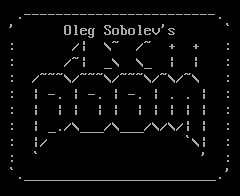Retro Replay Review
Gameplay
Oleg Sobolev’s ASCII Doom strips the classic DOOM formula down to its bare essentials: run through a maze, fire a shotgun, and survive. There are no demons with grotesque animations, no arsenal of weapons to unlock, and no health packs or power-ups to collect. What remains is the pure joy of line-of-fire shooting in a first-person perspective rendered entirely in ASCII characters. This singular focus creates a fast-paced rhythm where positioning and reaction time matter most.
(HEY YOU!! We hope you enjoy! We try not to run ads. So basically, this is a very expensive hobby running this site. Please consider joining us for updates, forums, and more. Network w/ us to make some cash or friends while retro gaming, and you can win some free retro games for posting. Okay, carry on 👍)
Without keycards, gates, or exploration-based puzzles, the gameplay loop is immediately accessible and demands little in the way of tutorials. Newcomers to retro-inspired shooters can jump in and understand the objective in seconds. However, this austere design also means there’s no sense of progression beyond clearing each corridor. For players craving complexity or variety, the experience can feel hollow after a short session.
Despite its simplicity, ASCII Doom does reward experimentation. Firing patterns, evasive maneuvers, and the occasional backpedal to catch a second wind all become part of a minimalist strategy. The lack of multiple weapon types or power-ups keeps the learning curve shallow, but mastering the shotgun’s limited spread and timing your shots in narrow passageways still offers a surprising challenge. In this sense, the game functions more as a test of skill than a narrative-driven adventure.
Graphics
Visually, ASCII Doom is a technical proof-of-concept rather than a full graphical overhaul. Its environments, enemies, and weapons are drawn entirely with ASCII characters—lines, slashes, letters, and numbers combine to form stick-figure silhouettes of foes and the outlines of walls. For retro enthusiasts, this harkens back to the earliest days of computer art, while modern audiences may appreciate the novelty and ingenuity of mapping a 3D space in plain text.
Compared to more polished retro ports like Doom, the Roguelike, Sobolev’s version may look crude, yet it boasts a visual sophistication unique to its medium. Each frame renders smoothly at console speeds, and the minimalist palette removes distractions, forcing players to rely on spatial awareness and pattern recognition. There are no textured walls or dynamic lighting effects—just bold ASCII glyphs conveying action in real time.
For fans of experimental graphics or terminal-based demos, ASCII Doom offers a refreshing break from pixel art or high-definition shaders. While it lacks colour and atmospheric detail, the abstract representation forces the imagination to fill in the gaps. The simple aesthetic can be charming and even hypnotic once you acclimatize to the shifting letters and numbers that stand in for monsters and corridors.
Story
Don’t expect an intricate narrative in ASCII Doom. There is no plot exposition, no cutscenes, and no in-game lore to uncover. Instead, the premise is purely functional: you are armed with a shotgun, trapped in a hostile maze, and charged with blasting anything that moves. The lack of a story framework underscores the project’s ambition as a coding exercise rather than a fleshed-out adventure.
That said, players with a vivid imagination may concoct their own backstories as they traverse the ASCII corridors. The rudimentary stickmen and blocky walls can serve as blank canvases for creative minds, prompting mental narratives about scientific experiments gone wrong or digital worlds on the brink of collapse. In this way, the minimalism becomes a feature, inviting personal interpretation wherever a more defined narrative might stifle it.
Ultimately, ASCII Doom’s narrative—or lack thereof—is unlikely to satisfy fans of story-driven shooters. If a richly layered plot or character development is what you seek, you’ll find this experience wanting. But if you approach it as an experiment in interactive coding and a tribute to DOOM’s raw gameplay loop, you’ll appreciate its purity and allow the mechanics themselves to tell the tale.
Overall Experience
ASCII Doom excels as a nostalgic showcase and a testament to creative coding. It pays homage to id Software’s original vision by distilling the core combat loop into a text-based environment. As a technical demo, it’s fascinating to see how much of the DOOM experience can survive when stripped of textures, sound effects, and level variety. For hobbyist programmers and retro gaming aficionados, this project offers insight and inspiration.
However, as a standalone entertainment product, ASCII Doom has clear limitations. The repetitive corridors, absence of enemy variety, and missing progression systems mean that play sessions rarely extend beyond a few minutes of intense action. There’s no multiplayer deathmatch, no environmental hazards like exploding barrels, and no collectible keycards to entice completionists. The game’s scope is narrow by design, and that simplicity will disappoint anyone looking for a full DOOM-esque adventure.
In the end, Oleg Sobolev’s ASCII Doom is best approached with the right expectations. It’s not a replacement for the original or for modern reinterpretations. Instead, it’s a minimalist curiosity that highlights the enduring appeal of DOOM’s core mechanics. If you’re intrigued by ASCII art, low-fi game development demos, or you simply want to experience a stripped-back version of a classic shooter, ASCII Doom delivers a concise, challenging glimpse into text-based combat. Otherwise, you may find its brevity and pared-down features leave you eager for more.
 Retro Replay Retro Replay gaming reviews, news, emulation, geek stuff and more!
Retro Replay Retro Replay gaming reviews, news, emulation, geek stuff and more!









Reviews
There are no reviews yet.